Optimising Care in Chronic Conditions
VerifiedAdded on 2021/05/30
|9
|2227
|31
AI Summary
Contribute Materials
Your contribution can guide someone’s learning journey. Share your
documents today.
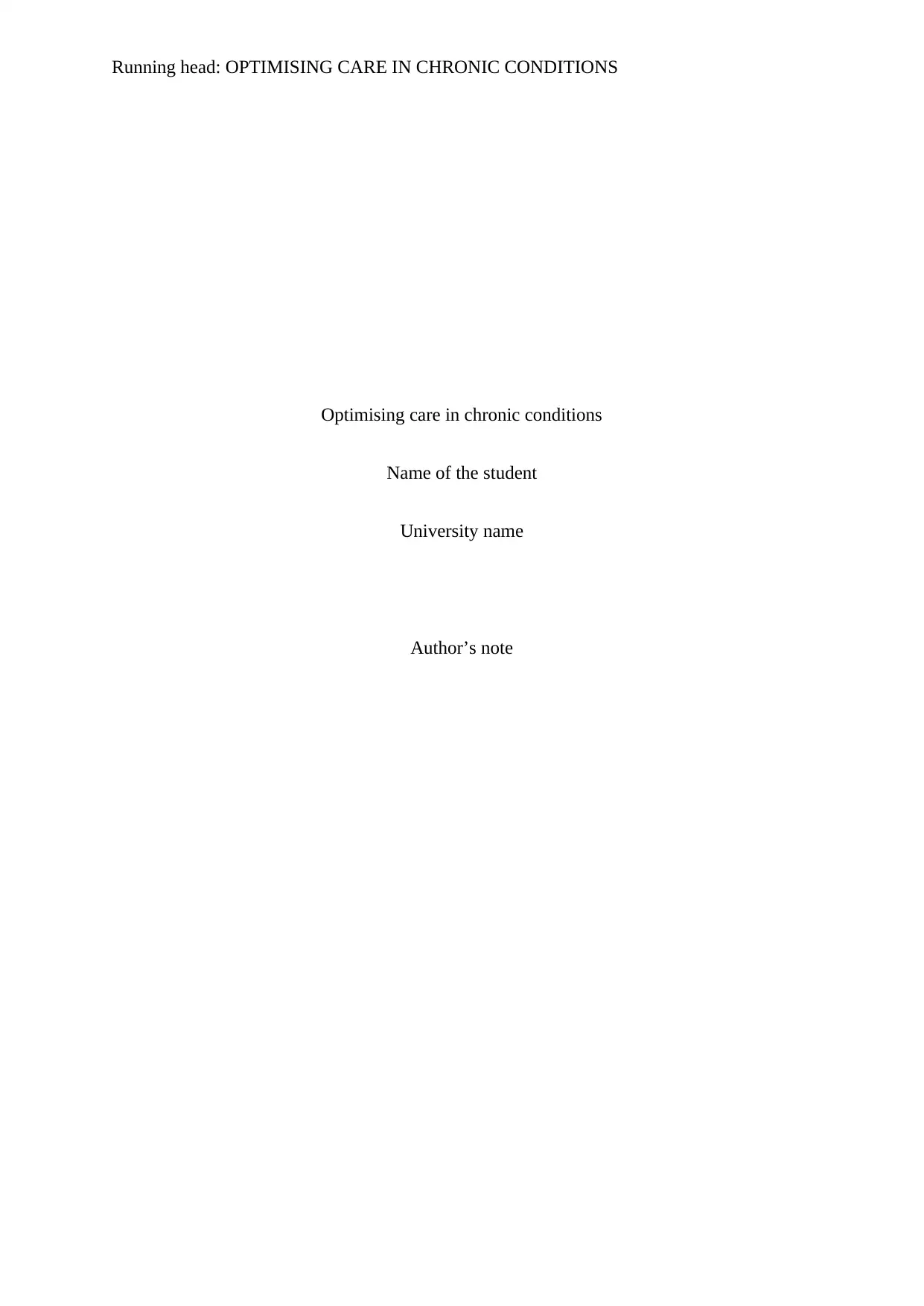
Running head: OPTIMISING CARE IN CHRONIC CONDITIONS
Optimising care in chronic conditions
Name of the student
University name
Author’s note
Optimising care in chronic conditions
Name of the student
University name
Author’s note
Secure Best Marks with AI Grader
Need help grading? Try our AI Grader for instant feedback on your assignments.
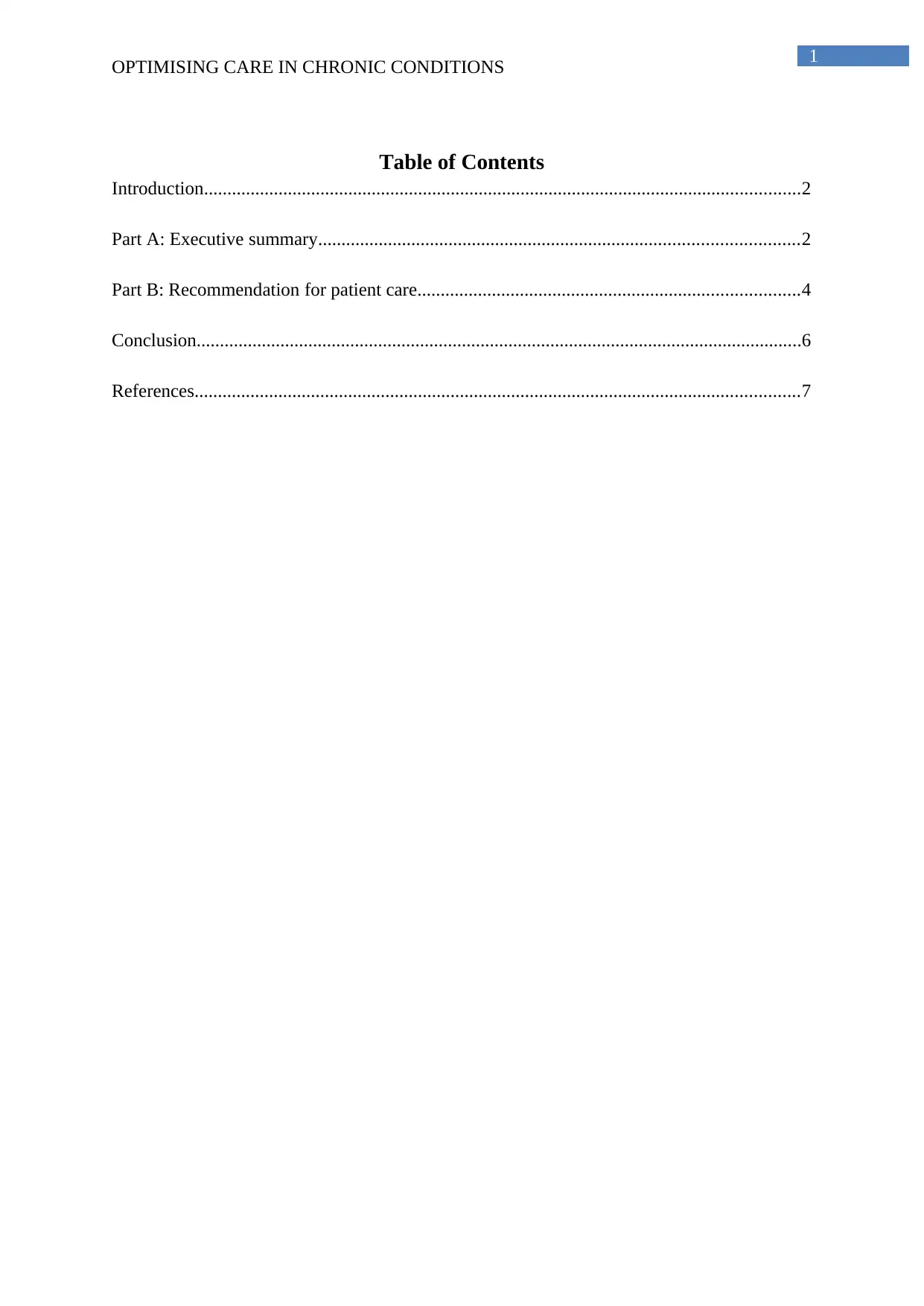
1
OPTIMISING CARE IN CHRONIC CONDITIONS
Table of Contents
Introduction................................................................................................................................2
Part A: Executive summary.......................................................................................................2
Part B: Recommendation for patient care..................................................................................4
Conclusion..................................................................................................................................6
References..................................................................................................................................7
OPTIMISING CARE IN CHRONIC CONDITIONS
Table of Contents
Introduction................................................................................................................................2
Part A: Executive summary.......................................................................................................2
Part B: Recommendation for patient care..................................................................................4
Conclusion..................................................................................................................................6
References..................................................................................................................................7
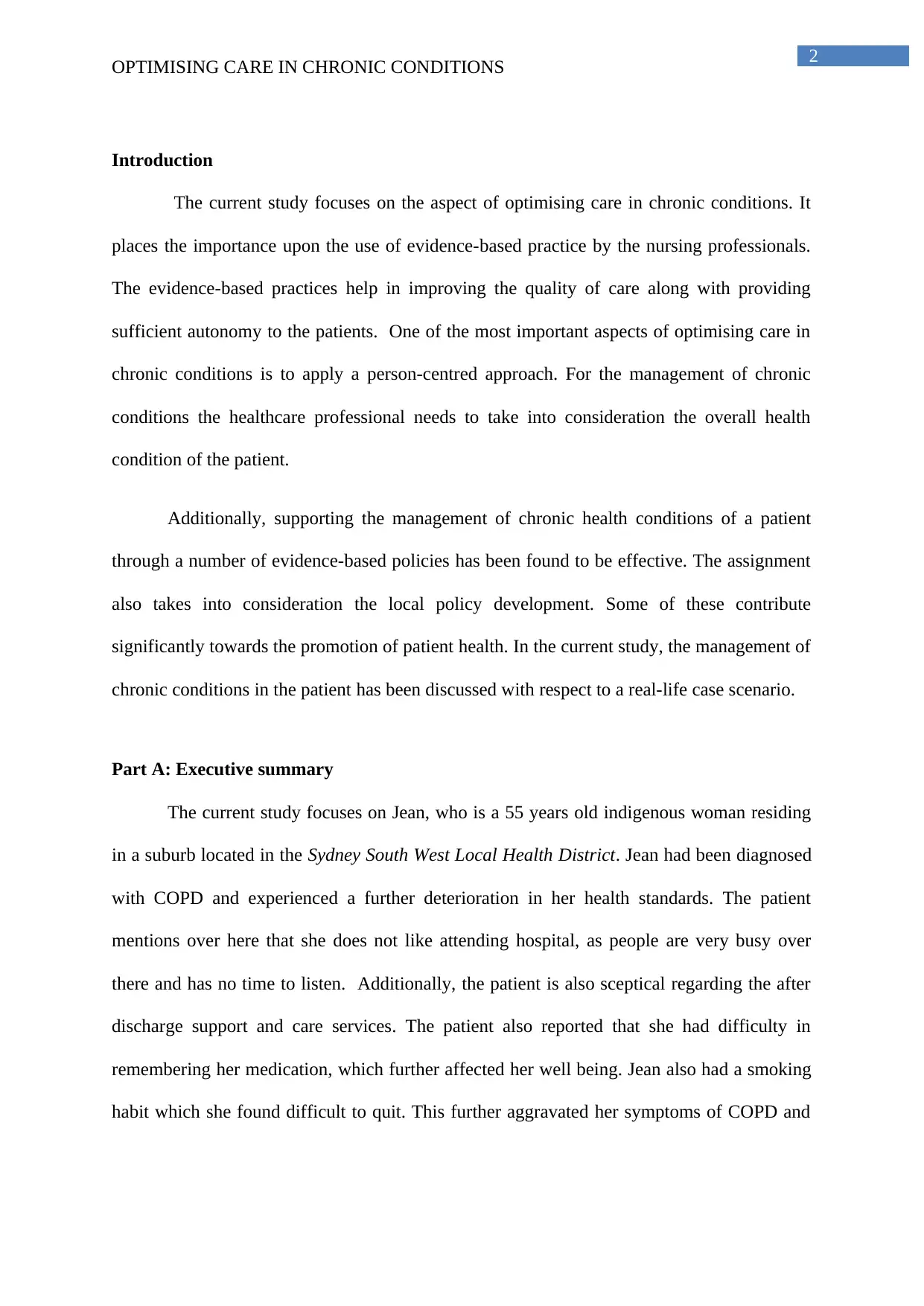
2
OPTIMISING CARE IN CHRONIC CONDITIONS
Introduction
The current study focuses on the aspect of optimising care in chronic conditions. It
places the importance upon the use of evidence-based practice by the nursing professionals.
The evidence-based practices help in improving the quality of care along with providing
sufficient autonomy to the patients. One of the most important aspects of optimising care in
chronic conditions is to apply a person-centred approach. For the management of chronic
conditions the healthcare professional needs to take into consideration the overall health
condition of the patient.
Additionally, supporting the management of chronic health conditions of a patient
through a number of evidence-based policies has been found to be effective. The assignment
also takes into consideration the local policy development. Some of these contribute
significantly towards the promotion of patient health. In the current study, the management of
chronic conditions in the patient has been discussed with respect to a real-life case scenario.
Part A: Executive summary
The current study focuses on Jean, who is a 55 years old indigenous woman residing
in a suburb located in the Sydney South West Local Health District. Jean had been diagnosed
with COPD and experienced a further deterioration in her health standards. The patient
mentions over here that she does not like attending hospital, as people are very busy over
there and has no time to listen. Additionally, the patient is also sceptical regarding the after
discharge support and care services. The patient also reported that she had difficulty in
remembering her medication, which further affected her well being. Jean also had a smoking
habit which she found difficult to quit. This further aggravated her symptoms of COPD and
OPTIMISING CARE IN CHRONIC CONDITIONS
Introduction
The current study focuses on the aspect of optimising care in chronic conditions. It
places the importance upon the use of evidence-based practice by the nursing professionals.
The evidence-based practices help in improving the quality of care along with providing
sufficient autonomy to the patients. One of the most important aspects of optimising care in
chronic conditions is to apply a person-centred approach. For the management of chronic
conditions the healthcare professional needs to take into consideration the overall health
condition of the patient.
Additionally, supporting the management of chronic health conditions of a patient
through a number of evidence-based policies has been found to be effective. The assignment
also takes into consideration the local policy development. Some of these contribute
significantly towards the promotion of patient health. In the current study, the management of
chronic conditions in the patient has been discussed with respect to a real-life case scenario.
Part A: Executive summary
The current study focuses on Jean, who is a 55 years old indigenous woman residing
in a suburb located in the Sydney South West Local Health District. Jean had been diagnosed
with COPD and experienced a further deterioration in her health standards. The patient
mentions over here that she does not like attending hospital, as people are very busy over
there and has no time to listen. Additionally, the patient is also sceptical regarding the after
discharge support and care services. The patient also reported that she had difficulty in
remembering her medication, which further affected her well being. Jean also had a smoking
habit which she found difficult to quit. This further aggravated her symptoms of COPD and
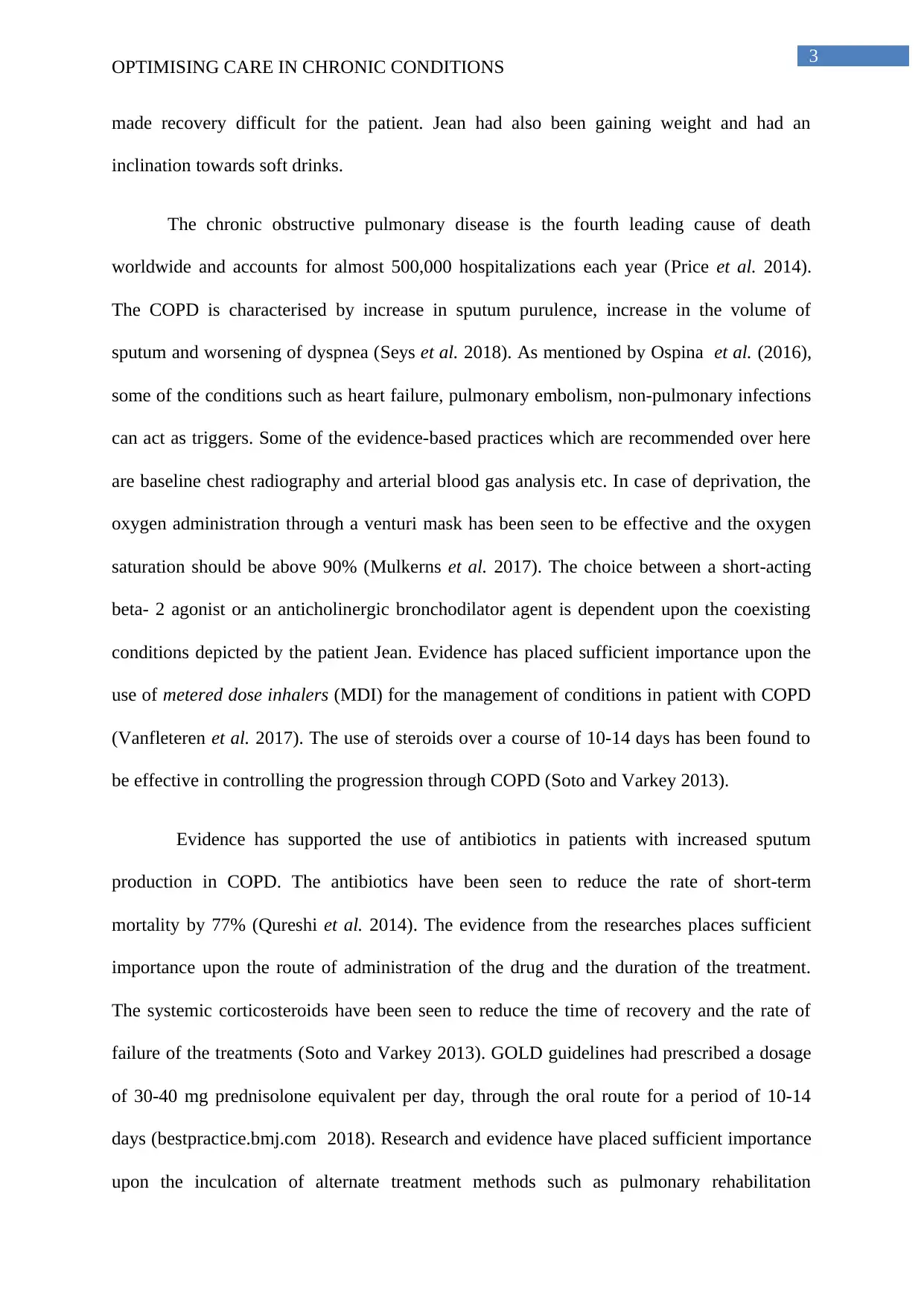
3
OPTIMISING CARE IN CHRONIC CONDITIONS
made recovery difficult for the patient. Jean had also been gaining weight and had an
inclination towards soft drinks.
The chronic obstructive pulmonary disease is the fourth leading cause of death
worldwide and accounts for almost 500,000 hospitalizations each year (Price et al. 2014).
The COPD is characterised by increase in sputum purulence, increase in the volume of
sputum and worsening of dyspnea (Seys et al. 2018). As mentioned by Ospina et al. (2016),
some of the conditions such as heart failure, pulmonary embolism, non-pulmonary infections
can act as triggers. Some of the evidence-based practices which are recommended over here
are baseline chest radiography and arterial blood gas analysis etc. In case of deprivation, the
oxygen administration through a venturi mask has been seen to be effective and the oxygen
saturation should be above 90% (Mulkerns et al. 2017). The choice between a short-acting
beta- 2 agonist or an anticholinergic bronchodilator agent is dependent upon the coexisting
conditions depicted by the patient Jean. Evidence has placed sufficient importance upon the
use of metered dose inhalers (MDI) for the management of conditions in patient with COPD
(Vanfleteren et al. 2017). The use of steroids over a course of 10-14 days has been found to
be effective in controlling the progression through COPD (Soto and Varkey 2013).
Evidence has supported the use of antibiotics in patients with increased sputum
production in COPD. The antibiotics have been seen to reduce the rate of short-term
mortality by 77% (Qureshi et al. 2014). The evidence from the researches places sufficient
importance upon the route of administration of the drug and the duration of the treatment.
The systemic corticosteroids have been seen to reduce the time of recovery and the rate of
failure of the treatments (Soto and Varkey 2013). GOLD guidelines had prescribed a dosage
of 30-40 mg prednisolone equivalent per day, through the oral route for a period of 10-14
days (bestpractice.bmj.com 2018). Research and evidence have placed sufficient importance
upon the inculcation of alternate treatment methods such as pulmonary rehabilitation
OPTIMISING CARE IN CHRONIC CONDITIONS
made recovery difficult for the patient. Jean had also been gaining weight and had an
inclination towards soft drinks.
The chronic obstructive pulmonary disease is the fourth leading cause of death
worldwide and accounts for almost 500,000 hospitalizations each year (Price et al. 2014).
The COPD is characterised by increase in sputum purulence, increase in the volume of
sputum and worsening of dyspnea (Seys et al. 2018). As mentioned by Ospina et al. (2016),
some of the conditions such as heart failure, pulmonary embolism, non-pulmonary infections
can act as triggers. Some of the evidence-based practices which are recommended over here
are baseline chest radiography and arterial blood gas analysis etc. In case of deprivation, the
oxygen administration through a venturi mask has been seen to be effective and the oxygen
saturation should be above 90% (Mulkerns et al. 2017). The choice between a short-acting
beta- 2 agonist or an anticholinergic bronchodilator agent is dependent upon the coexisting
conditions depicted by the patient Jean. Evidence has placed sufficient importance upon the
use of metered dose inhalers (MDI) for the management of conditions in patient with COPD
(Vanfleteren et al. 2017). The use of steroids over a course of 10-14 days has been found to
be effective in controlling the progression through COPD (Soto and Varkey 2013).
Evidence has supported the use of antibiotics in patients with increased sputum
production in COPD. The antibiotics have been seen to reduce the rate of short-term
mortality by 77% (Qureshi et al. 2014). The evidence from the researches places sufficient
importance upon the route of administration of the drug and the duration of the treatment.
The systemic corticosteroids have been seen to reduce the time of recovery and the rate of
failure of the treatments (Soto and Varkey 2013). GOLD guidelines had prescribed a dosage
of 30-40 mg prednisolone equivalent per day, through the oral route for a period of 10-14
days (bestpractice.bmj.com 2018). Research and evidence have placed sufficient importance
upon the inculcation of alternate treatment methods such as pulmonary rehabilitation
Secure Best Marks with AI Grader
Need help grading? Try our AI Grader for instant feedback on your assignments.
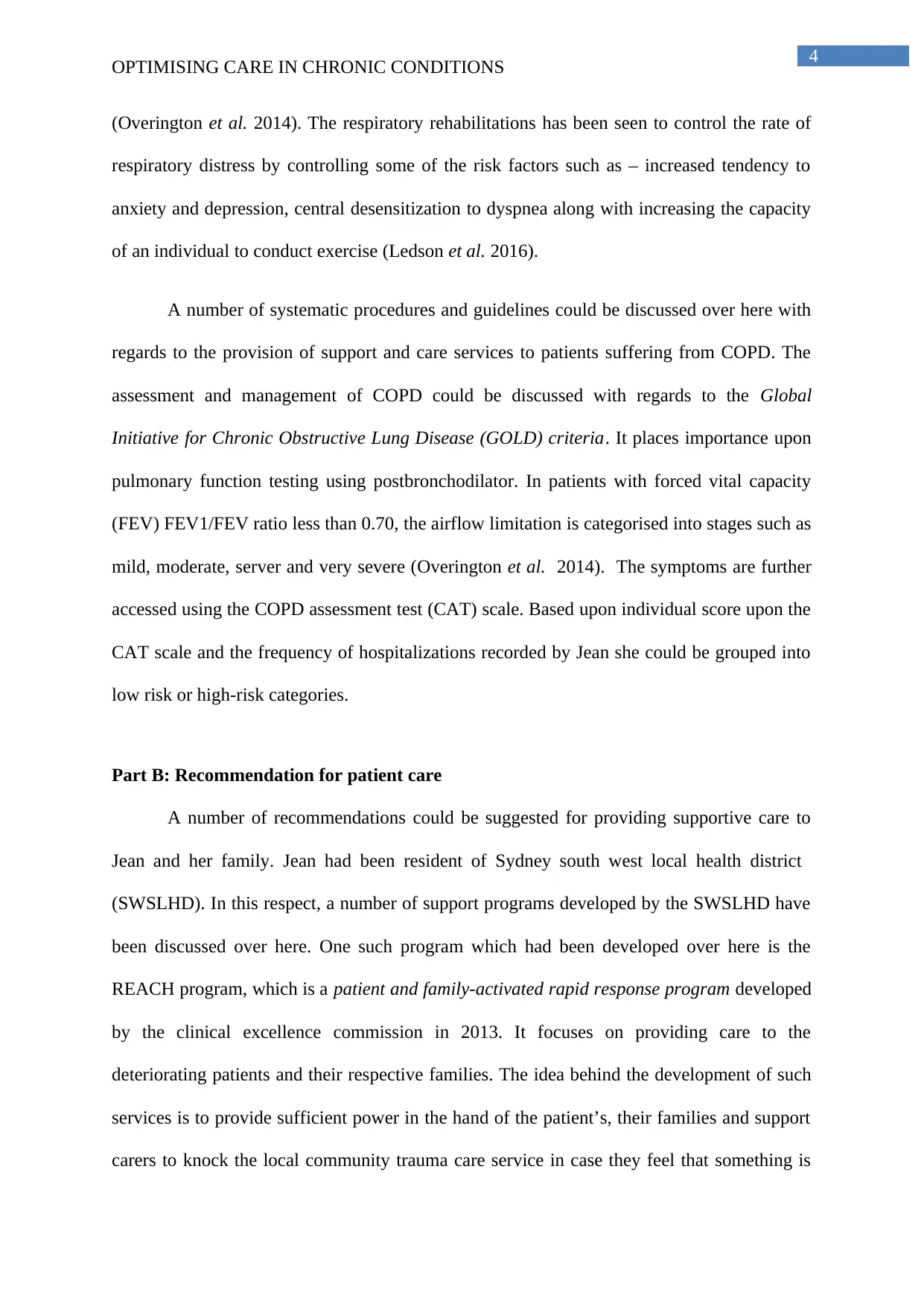
4
OPTIMISING CARE IN CHRONIC CONDITIONS
(Overington et al. 2014). The respiratory rehabilitations has been seen to control the rate of
respiratory distress by controlling some of the risk factors such as – increased tendency to
anxiety and depression, central desensitization to dyspnea along with increasing the capacity
of an individual to conduct exercise (Ledson et al. 2016).
A number of systematic procedures and guidelines could be discussed over here with
regards to the provision of support and care services to patients suffering from COPD. The
assessment and management of COPD could be discussed with regards to the Global
Initiative for Chronic Obstructive Lung Disease (GOLD) criteria. It places importance upon
pulmonary function testing using postbronchodilator. In patients with forced vital capacity
(FEV) FEV1/FEV ratio less than 0.70, the airflow limitation is categorised into stages such as
mild, moderate, server and very severe (Overington et al. 2014). The symptoms are further
accessed using the COPD assessment test (CAT) scale. Based upon individual score upon the
CAT scale and the frequency of hospitalizations recorded by Jean she could be grouped into
low risk or high-risk categories.
Part B: Recommendation for patient care
A number of recommendations could be suggested for providing supportive care to
Jean and her family. Jean had been resident of Sydney south west local health district
(SWSLHD). In this respect, a number of support programs developed by the SWSLHD have
been discussed over here. One such program which had been developed over here is the
REACH program, which is a patient and family-activated rapid response program developed
by the clinical excellence commission in 2013. It focuses on providing care to the
deteriorating patients and their respective families. The idea behind the development of such
services is to provide sufficient power in the hand of the patient’s, their families and support
carers to knock the local community trauma care service in case they feel that something is
OPTIMISING CARE IN CHRONIC CONDITIONS
(Overington et al. 2014). The respiratory rehabilitations has been seen to control the rate of
respiratory distress by controlling some of the risk factors such as – increased tendency to
anxiety and depression, central desensitization to dyspnea along with increasing the capacity
of an individual to conduct exercise (Ledson et al. 2016).
A number of systematic procedures and guidelines could be discussed over here with
regards to the provision of support and care services to patients suffering from COPD. The
assessment and management of COPD could be discussed with regards to the Global
Initiative for Chronic Obstructive Lung Disease (GOLD) criteria. It places importance upon
pulmonary function testing using postbronchodilator. In patients with forced vital capacity
(FEV) FEV1/FEV ratio less than 0.70, the airflow limitation is categorised into stages such as
mild, moderate, server and very severe (Overington et al. 2014). The symptoms are further
accessed using the COPD assessment test (CAT) scale. Based upon individual score upon the
CAT scale and the frequency of hospitalizations recorded by Jean she could be grouped into
low risk or high-risk categories.
Part B: Recommendation for patient care
A number of recommendations could be suggested for providing supportive care to
Jean and her family. Jean had been resident of Sydney south west local health district
(SWSLHD). In this respect, a number of support programs developed by the SWSLHD have
been discussed over here. One such program which had been developed over here is the
REACH program, which is a patient and family-activated rapid response program developed
by the clinical excellence commission in 2013. It focuses on providing care to the
deteriorating patients and their respective families. The idea behind the development of such
services is to provide sufficient power in the hand of the patient’s, their families and support
carers to knock the local community trauma care service in case they feel that something is
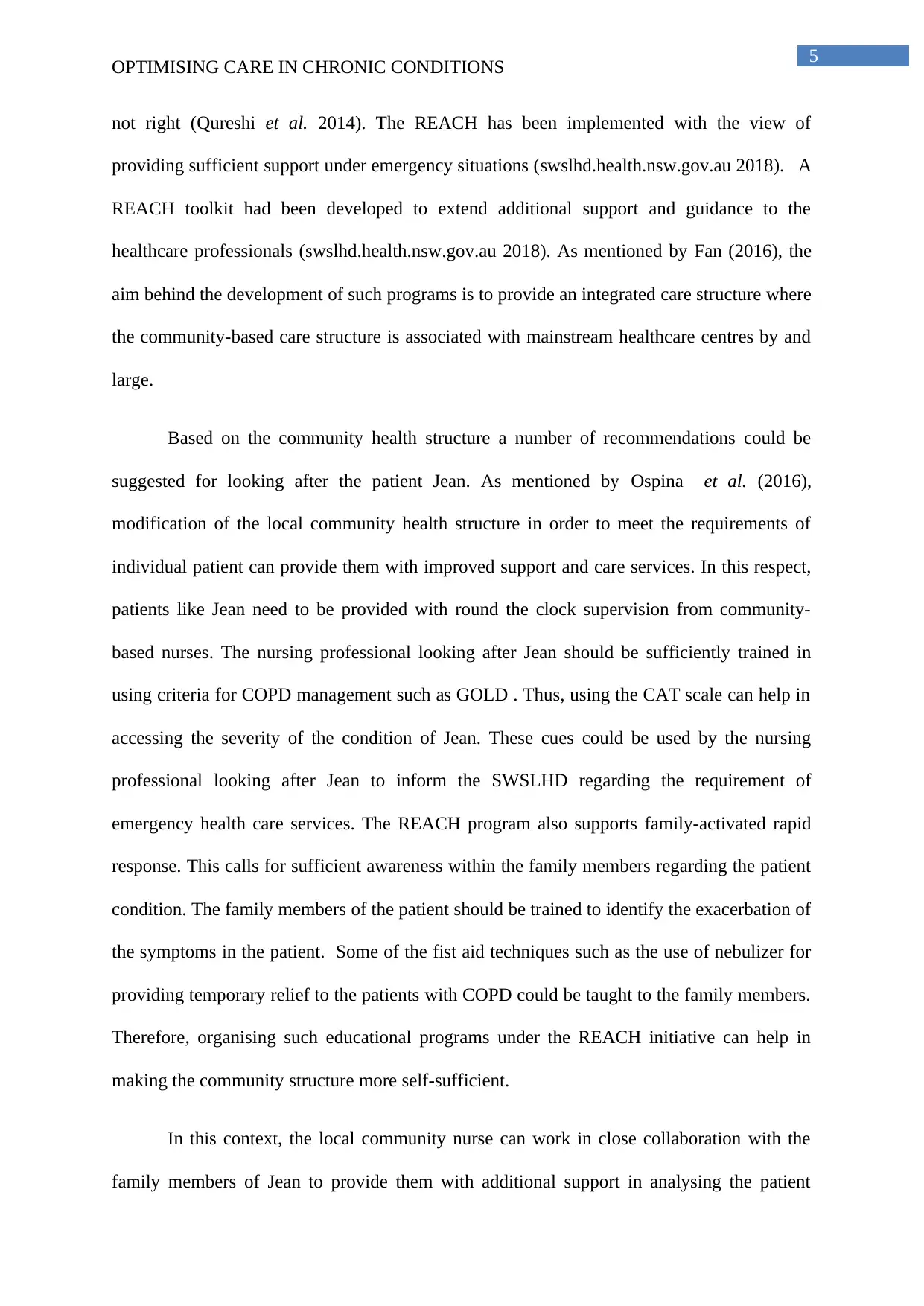
5
OPTIMISING CARE IN CHRONIC CONDITIONS
not right (Qureshi et al. 2014). The REACH has been implemented with the view of
providing sufficient support under emergency situations (swslhd.health.nsw.gov.au 2018). A
REACH toolkit had been developed to extend additional support and guidance to the
healthcare professionals (swslhd.health.nsw.gov.au 2018). As mentioned by Fan (2016), the
aim behind the development of such programs is to provide an integrated care structure where
the community-based care structure is associated with mainstream healthcare centres by and
large.
Based on the community health structure a number of recommendations could be
suggested for looking after the patient Jean. As mentioned by Ospina et al. (2016),
modification of the local community health structure in order to meet the requirements of
individual patient can provide them with improved support and care services. In this respect,
patients like Jean need to be provided with round the clock supervision from community-
based nurses. The nursing professional looking after Jean should be sufficiently trained in
using criteria for COPD management such as GOLD . Thus, using the CAT scale can help in
accessing the severity of the condition of Jean. These cues could be used by the nursing
professional looking after Jean to inform the SWSLHD regarding the requirement of
emergency health care services. The REACH program also supports family-activated rapid
response. This calls for sufficient awareness within the family members regarding the patient
condition. The family members of the patient should be trained to identify the exacerbation of
the symptoms in the patient. Some of the fist aid techniques such as the use of nebulizer for
providing temporary relief to the patients with COPD could be taught to the family members.
Therefore, organising such educational programs under the REACH initiative can help in
making the community structure more self-sufficient.
In this context, the local community nurse can work in close collaboration with the
family members of Jean to provide them with additional support in analysing the patient
OPTIMISING CARE IN CHRONIC CONDITIONS
not right (Qureshi et al. 2014). The REACH has been implemented with the view of
providing sufficient support under emergency situations (swslhd.health.nsw.gov.au 2018). A
REACH toolkit had been developed to extend additional support and guidance to the
healthcare professionals (swslhd.health.nsw.gov.au 2018). As mentioned by Fan (2016), the
aim behind the development of such programs is to provide an integrated care structure where
the community-based care structure is associated with mainstream healthcare centres by and
large.
Based on the community health structure a number of recommendations could be
suggested for looking after the patient Jean. As mentioned by Ospina et al. (2016),
modification of the local community health structure in order to meet the requirements of
individual patient can provide them with improved support and care services. In this respect,
patients like Jean need to be provided with round the clock supervision from community-
based nurses. The nursing professional looking after Jean should be sufficiently trained in
using criteria for COPD management such as GOLD . Thus, using the CAT scale can help in
accessing the severity of the condition of Jean. These cues could be used by the nursing
professional looking after Jean to inform the SWSLHD regarding the requirement of
emergency health care services. The REACH program also supports family-activated rapid
response. This calls for sufficient awareness within the family members regarding the patient
condition. The family members of the patient should be trained to identify the exacerbation of
the symptoms in the patient. Some of the fist aid techniques such as the use of nebulizer for
providing temporary relief to the patients with COPD could be taught to the family members.
Therefore, organising such educational programs under the REACH initiative can help in
making the community structure more self-sufficient.
In this context, the local community nurse can work in close collaboration with the
family members of Jean to provide them with additional support in analysing the patient
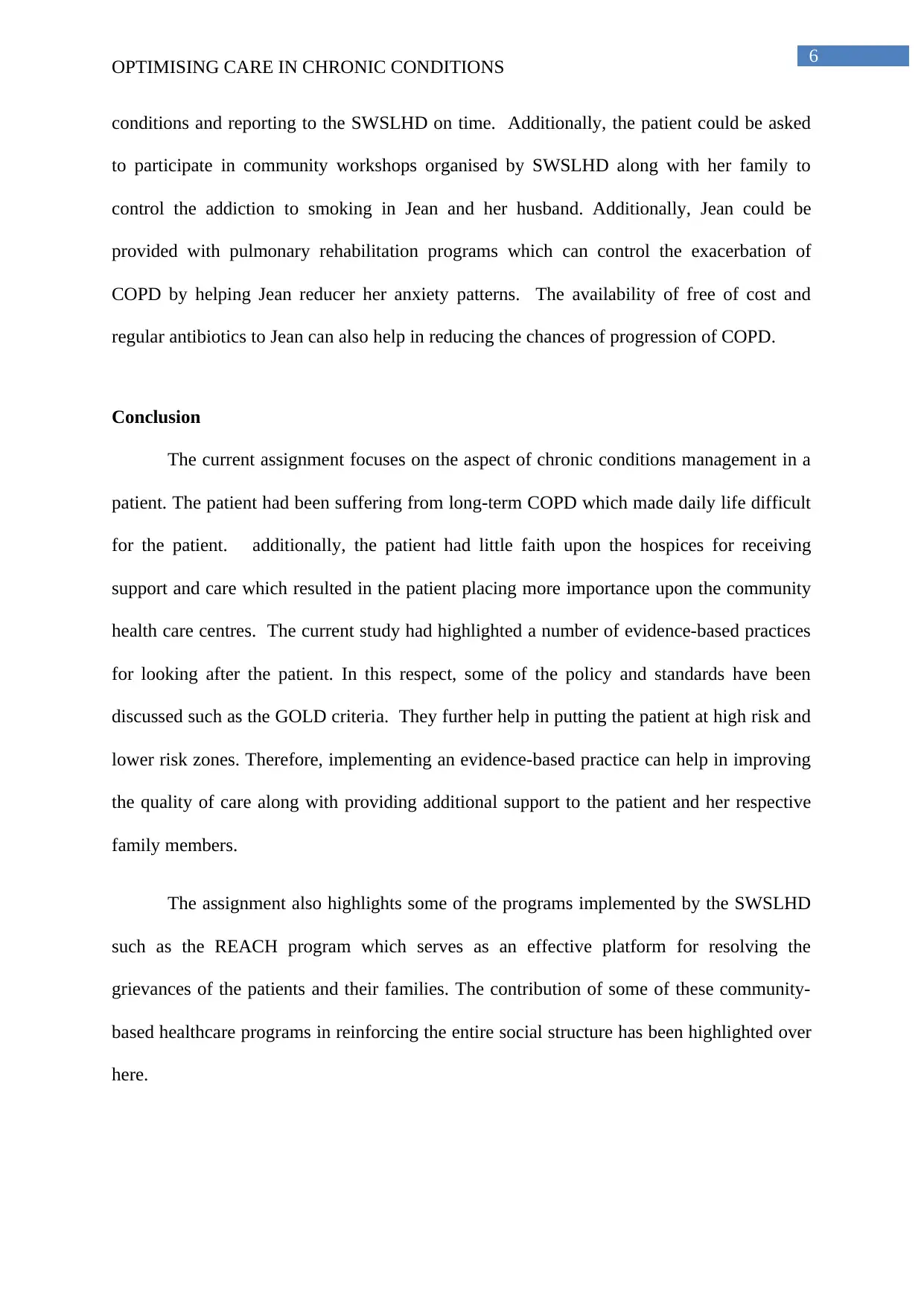
6
OPTIMISING CARE IN CHRONIC CONDITIONS
conditions and reporting to the SWSLHD on time. Additionally, the patient could be asked
to participate in community workshops organised by SWSLHD along with her family to
control the addiction to smoking in Jean and her husband. Additionally, Jean could be
provided with pulmonary rehabilitation programs which can control the exacerbation of
COPD by helping Jean reducer her anxiety patterns. The availability of free of cost and
regular antibiotics to Jean can also help in reducing the chances of progression of COPD.
Conclusion
The current assignment focuses on the aspect of chronic conditions management in a
patient. The patient had been suffering from long-term COPD which made daily life difficult
for the patient. additionally, the patient had little faith upon the hospices for receiving
support and care which resulted in the patient placing more importance upon the community
health care centres. The current study had highlighted a number of evidence-based practices
for looking after the patient. In this respect, some of the policy and standards have been
discussed such as the GOLD criteria. They further help in putting the patient at high risk and
lower risk zones. Therefore, implementing an evidence-based practice can help in improving
the quality of care along with providing additional support to the patient and her respective
family members.
The assignment also highlights some of the programs implemented by the SWSLHD
such as the REACH program which serves as an effective platform for resolving the
grievances of the patients and their families. The contribution of some of these community-
based healthcare programs in reinforcing the entire social structure has been highlighted over
here.
OPTIMISING CARE IN CHRONIC CONDITIONS
conditions and reporting to the SWSLHD on time. Additionally, the patient could be asked
to participate in community workshops organised by SWSLHD along with her family to
control the addiction to smoking in Jean and her husband. Additionally, Jean could be
provided with pulmonary rehabilitation programs which can control the exacerbation of
COPD by helping Jean reducer her anxiety patterns. The availability of free of cost and
regular antibiotics to Jean can also help in reducing the chances of progression of COPD.
Conclusion
The current assignment focuses on the aspect of chronic conditions management in a
patient. The patient had been suffering from long-term COPD which made daily life difficult
for the patient. additionally, the patient had little faith upon the hospices for receiving
support and care which resulted in the patient placing more importance upon the community
health care centres. The current study had highlighted a number of evidence-based practices
for looking after the patient. In this respect, some of the policy and standards have been
discussed such as the GOLD criteria. They further help in putting the patient at high risk and
lower risk zones. Therefore, implementing an evidence-based practice can help in improving
the quality of care along with providing additional support to the patient and her respective
family members.
The assignment also highlights some of the programs implemented by the SWSLHD
such as the REACH program which serves as an effective platform for resolving the
grievances of the patients and their families. The contribution of some of these community-
based healthcare programs in reinforcing the entire social structure has been highlighted over
here.
Paraphrase This Document
Need a fresh take? Get an instant paraphrase of this document with our AI Paraphraser
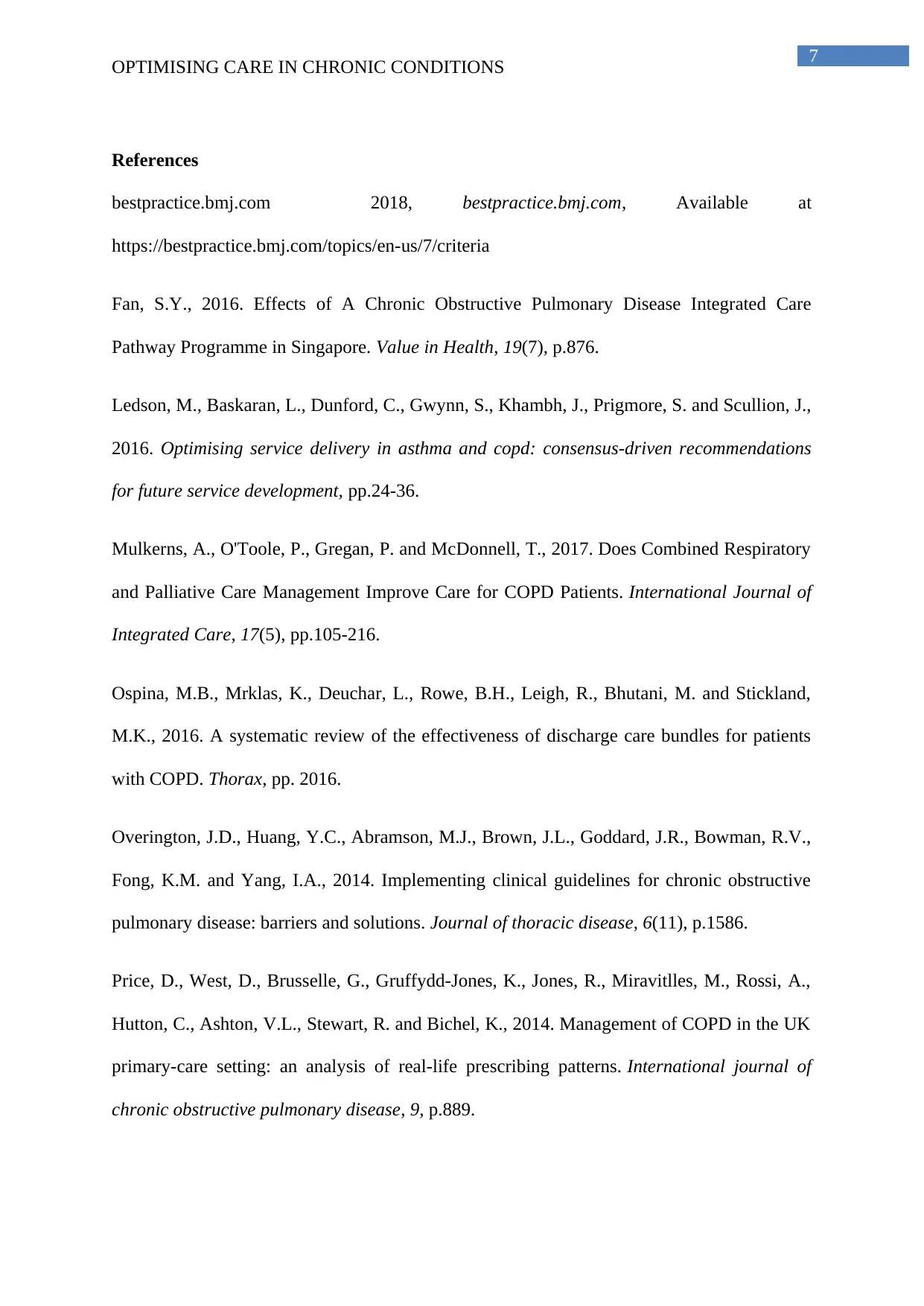
7
OPTIMISING CARE IN CHRONIC CONDITIONS
References
bestpractice.bmj.com 2018, bestpractice.bmj.com, Available at
https://bestpractice.bmj.com/topics/en-us/7/criteria
Fan, S.Y., 2016. Effects of A Chronic Obstructive Pulmonary Disease Integrated Care
Pathway Programme in Singapore. Value in Health, 19(7), p.876.
Ledson, M., Baskaran, L., Dunford, C., Gwynn, S., Khambh, J., Prigmore, S. and Scullion, J.,
2016. Optimising service delivery in asthma and copd: consensus-driven recommendations
for future service development, pp.24-36.
Mulkerns, A., O'Toole, P., Gregan, P. and McDonnell, T., 2017. Does Combined Respiratory
and Palliative Care Management Improve Care for COPD Patients. International Journal of
Integrated Care, 17(5), pp.105-216.
Ospina, M.B., Mrklas, K., Deuchar, L., Rowe, B.H., Leigh, R., Bhutani, M. and Stickland,
M.K., 2016. A systematic review of the effectiveness of discharge care bundles for patients
with COPD. Thorax, pp. 2016.
Overington, J.D., Huang, Y.C., Abramson, M.J., Brown, J.L., Goddard, J.R., Bowman, R.V.,
Fong, K.M. and Yang, I.A., 2014. Implementing clinical guidelines for chronic obstructive
pulmonary disease: barriers and solutions. Journal of thoracic disease, 6(11), p.1586.
Price, D., West, D., Brusselle, G., Gruffydd-Jones, K., Jones, R., Miravitlles, M., Rossi, A.,
Hutton, C., Ashton, V.L., Stewart, R. and Bichel, K., 2014. Management of COPD in the UK
primary-care setting: an analysis of real-life prescribing patterns. International journal of
chronic obstructive pulmonary disease, 9, p.889.
OPTIMISING CARE IN CHRONIC CONDITIONS
References
bestpractice.bmj.com 2018, bestpractice.bmj.com, Available at
https://bestpractice.bmj.com/topics/en-us/7/criteria
Fan, S.Y., 2016. Effects of A Chronic Obstructive Pulmonary Disease Integrated Care
Pathway Programme in Singapore. Value in Health, 19(7), p.876.
Ledson, M., Baskaran, L., Dunford, C., Gwynn, S., Khambh, J., Prigmore, S. and Scullion, J.,
2016. Optimising service delivery in asthma and copd: consensus-driven recommendations
for future service development, pp.24-36.
Mulkerns, A., O'Toole, P., Gregan, P. and McDonnell, T., 2017. Does Combined Respiratory
and Palliative Care Management Improve Care for COPD Patients. International Journal of
Integrated Care, 17(5), pp.105-216.
Ospina, M.B., Mrklas, K., Deuchar, L., Rowe, B.H., Leigh, R., Bhutani, M. and Stickland,
M.K., 2016. A systematic review of the effectiveness of discharge care bundles for patients
with COPD. Thorax, pp. 2016.
Overington, J.D., Huang, Y.C., Abramson, M.J., Brown, J.L., Goddard, J.R., Bowman, R.V.,
Fong, K.M. and Yang, I.A., 2014. Implementing clinical guidelines for chronic obstructive
pulmonary disease: barriers and solutions. Journal of thoracic disease, 6(11), p.1586.
Price, D., West, D., Brusselle, G., Gruffydd-Jones, K., Jones, R., Miravitlles, M., Rossi, A.,
Hutton, C., Ashton, V.L., Stewart, R. and Bichel, K., 2014. Management of COPD in the UK
primary-care setting: an analysis of real-life prescribing patterns. International journal of
chronic obstructive pulmonary disease, 9, p.889.
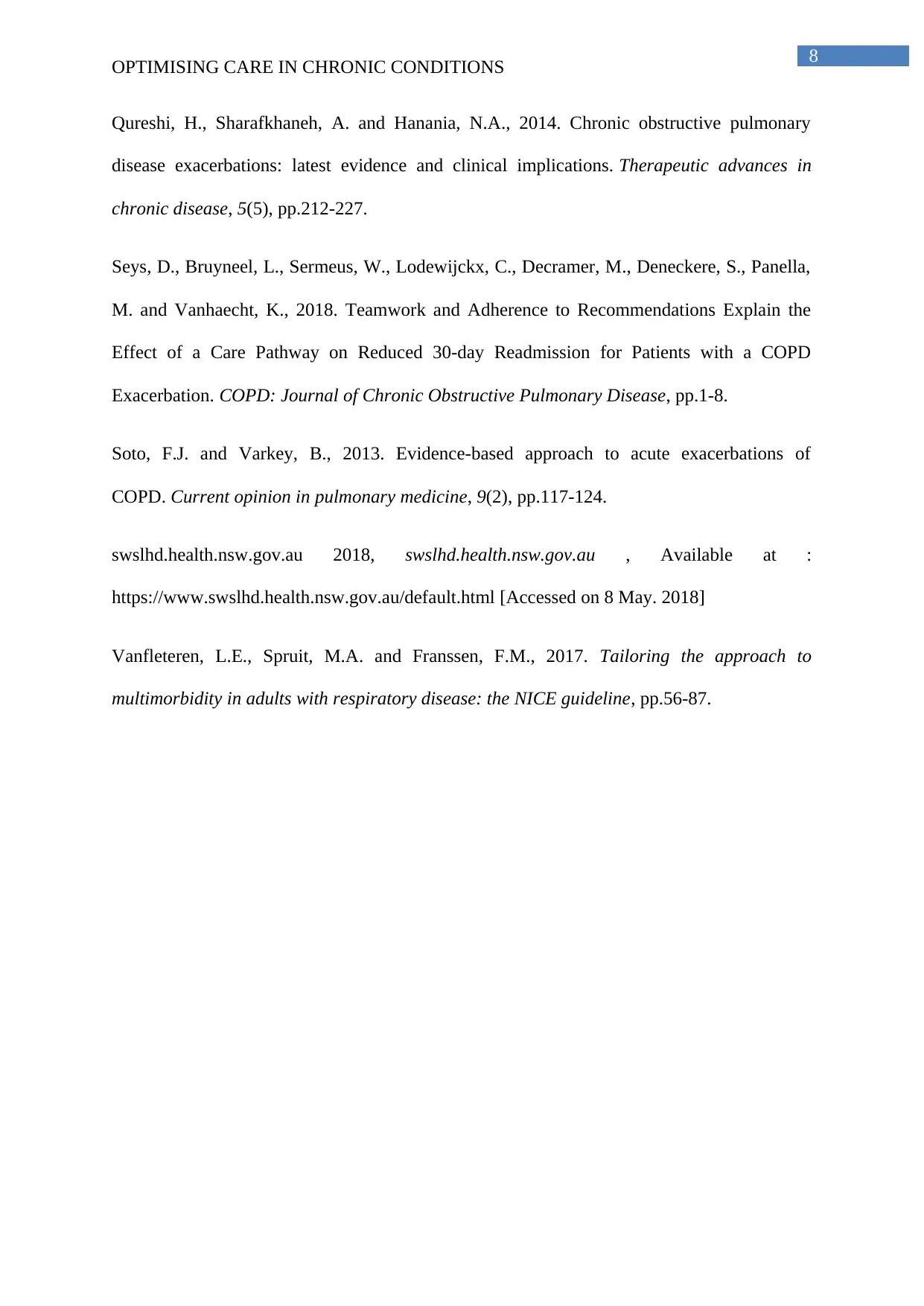
8
OPTIMISING CARE IN CHRONIC CONDITIONS
Qureshi, H., Sharafkhaneh, A. and Hanania, N.A., 2014. Chronic obstructive pulmonary
disease exacerbations: latest evidence and clinical implications. Therapeutic advances in
chronic disease, 5(5), pp.212-227.
Seys, D., Bruyneel, L., Sermeus, W., Lodewijckx, C., Decramer, M., Deneckere, S., Panella,
M. and Vanhaecht, K., 2018. Teamwork and Adherence to Recommendations Explain the
Effect of a Care Pathway on Reduced 30-day Readmission for Patients with a COPD
Exacerbation. COPD: Journal of Chronic Obstructive Pulmonary Disease, pp.1-8.
Soto, F.J. and Varkey, B., 2013. Evidence-based approach to acute exacerbations of
COPD. Current opinion in pulmonary medicine, 9(2), pp.117-124.
swslhd.health.nsw.gov.au 2018, swslhd.health.nsw.gov.au , Available at :
https://www.swslhd.health.nsw.gov.au/default.html [Accessed on 8 May. 2018]
Vanfleteren, L.E., Spruit, M.A. and Franssen, F.M., 2017. Tailoring the approach to
multimorbidity in adults with respiratory disease: the NICE guideline, pp.56-87.
OPTIMISING CARE IN CHRONIC CONDITIONS
Qureshi, H., Sharafkhaneh, A. and Hanania, N.A., 2014. Chronic obstructive pulmonary
disease exacerbations: latest evidence and clinical implications. Therapeutic advances in
chronic disease, 5(5), pp.212-227.
Seys, D., Bruyneel, L., Sermeus, W., Lodewijckx, C., Decramer, M., Deneckere, S., Panella,
M. and Vanhaecht, K., 2018. Teamwork and Adherence to Recommendations Explain the
Effect of a Care Pathway on Reduced 30-day Readmission for Patients with a COPD
Exacerbation. COPD: Journal of Chronic Obstructive Pulmonary Disease, pp.1-8.
Soto, F.J. and Varkey, B., 2013. Evidence-based approach to acute exacerbations of
COPD. Current opinion in pulmonary medicine, 9(2), pp.117-124.
swslhd.health.nsw.gov.au 2018, swslhd.health.nsw.gov.au , Available at :
https://www.swslhd.health.nsw.gov.au/default.html [Accessed on 8 May. 2018]
Vanfleteren, L.E., Spruit, M.A. and Franssen, F.M., 2017. Tailoring the approach to
multimorbidity in adults with respiratory disease: the NICE guideline, pp.56-87.
1 out of 9
Related Documents
Your All-in-One AI-Powered Toolkit for Academic Success.
+13062052269
info@desklib.com
Available 24*7 on WhatsApp / Email
![[object Object]](/_next/static/media/star-bottom.7253800d.svg)
Unlock your academic potential
© 2024 | Zucol Services PVT LTD | All rights reserved.





